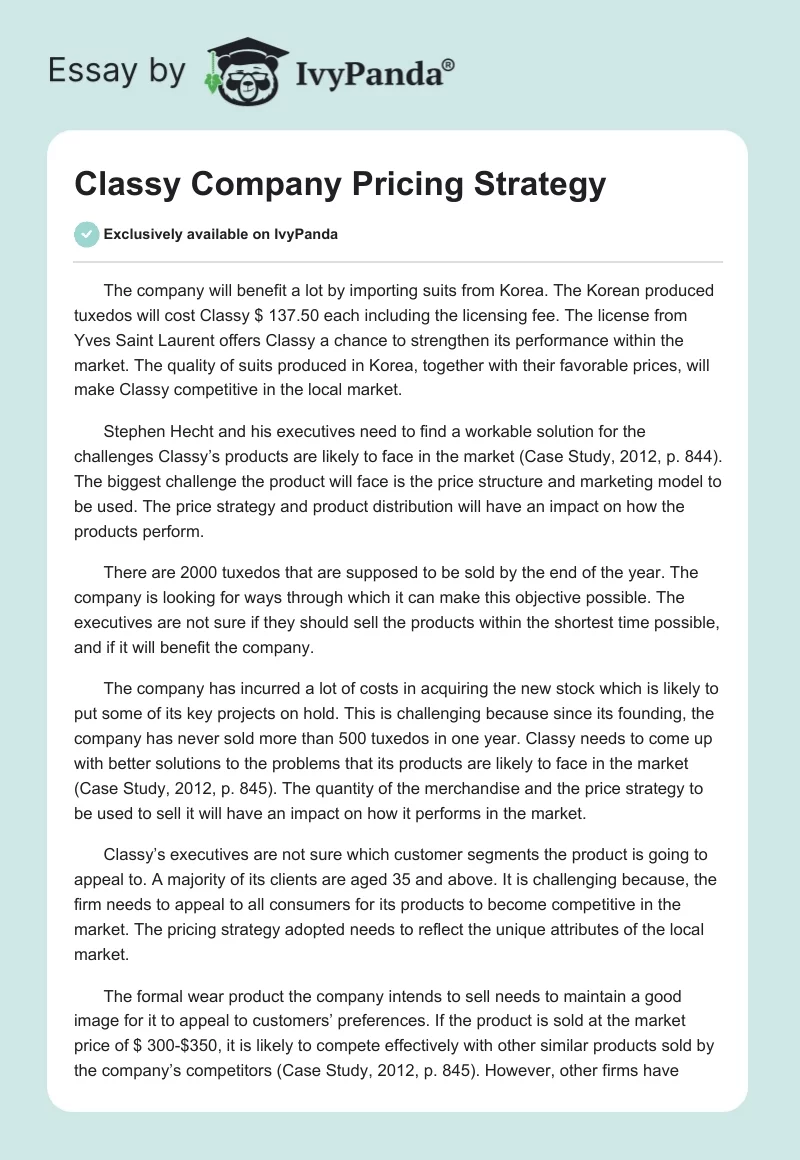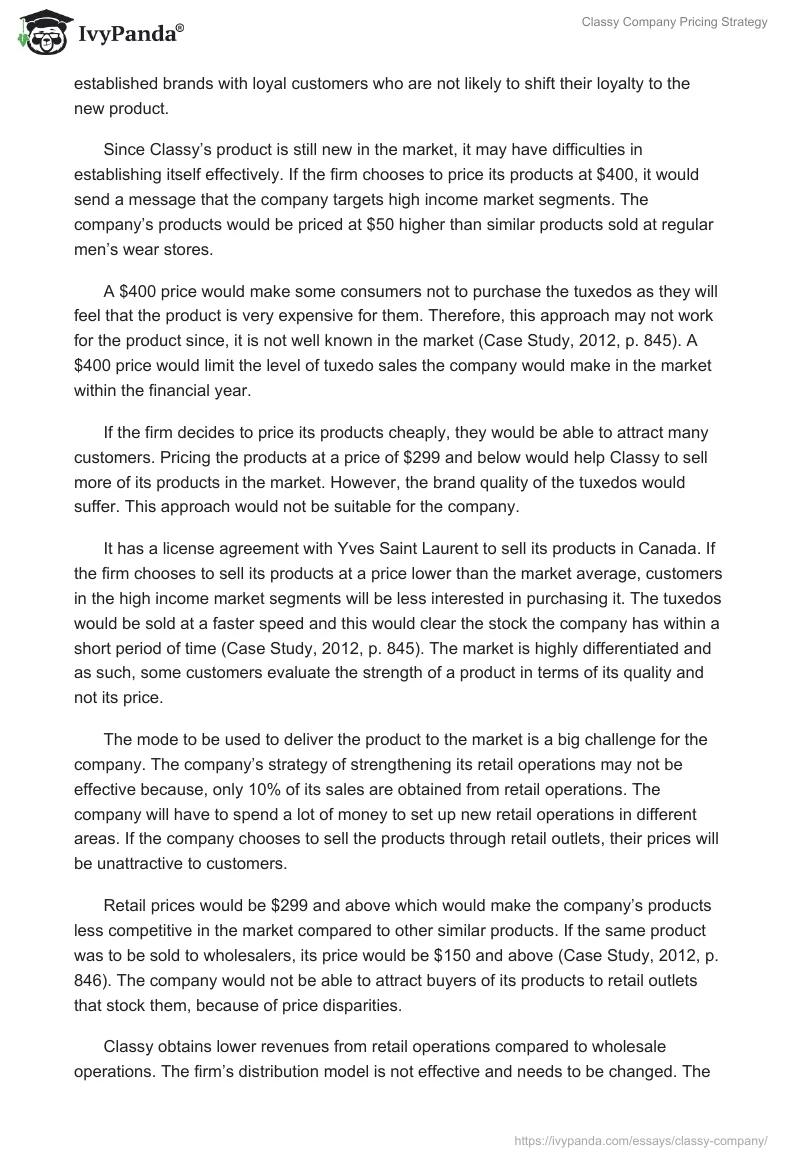The company will benefit a lot by importing suits from Korea. The Korean produced tuxedos will cost Classy $ 137.50 each including the licensing fee. The license from Yves Saint Laurent offers Classy a chance to strengthen its performance within the market. The quality of suits produced in Korea, together with their favorable prices, will make Classy competitive in the local market.
Stephen Hecht and his executives need to find a workable solution for the challenges Classy’s products are likely to face in the market (Case Study, 2012, p. 844). The biggest challenge the product will face is the price structure and marketing model to be used. The price strategy and product distribution will have an impact on how the products perform.
There are 2000 tuxedos that are supposed to be sold by the end of the year. The company is looking for ways through which it can make this objective possible. The executives are not sure if they should sell the products within the shortest time possible, and if it will benefit the company.
The company has incurred a lot of costs in acquiring the new stock which is likely to put some of its key projects on hold. This is challenging because since its founding, the company has never sold more than 500 tuxedos in one year. Classy needs to come up with better solutions to the problems that its products are likely to face in the market (Case Study, 2012, p. 845). The quantity of the merchandise and the price strategy to be used to sell it will have an impact on how it performs in the market.
Classy’s executives are not sure which customer segments the product is going to appeal to. A majority of its clients are aged 35 and above. It is challenging because, the firm needs to appeal to all consumers for its products to become competitive in the market. The pricing strategy adopted needs to reflect the unique attributes of the local market.
The formal wear product the company intends to sell needs to maintain a good image for it to appeal to customers’ preferences. If the product is sold at the market price of $ 300-$350, it is likely to compete effectively with other similar products sold by the company’s competitors (Case Study, 2012, p. 845). However, other firms have established brands with loyal customers who are not likely to shift their loyalty to the new product.
Since Classy’s product is still new in the market, it may have difficulties in establishing itself effectively. If the firm chooses to price its products at $400, it would send a message that the company targets high income market segments. The company’s products would be priced at $50 higher than similar products sold at regular men’s wear stores.
A $400 price would make some consumers not to purchase the tuxedos as they will feel that the product is very expensive for them. Therefore, this approach may not work for the product since, it is not well known in the market (Case Study, 2012, p. 845). A $400 price would limit the level of tuxedo sales the company would make in the market within the financial year.
If the firm decides to price its products cheaply, they would be able to attract many customers. Pricing the products at a price of $299 and below would help Classy to sell more of its products in the market. However, the brand quality of the tuxedos would suffer. This approach would not be suitable for the company.
It has a license agreement with Yves Saint Laurent to sell its products in Canada. If the firm chooses to sell its products at a price lower than the market average, customers in the high income market segments will be less interested in purchasing it. The tuxedos would be sold at a faster speed and this would clear the stock the company has within a short period of time (Case Study, 2012, p. 845). The market is highly differentiated and as such, some customers evaluate the strength of a product in terms of its quality and not its price.
The mode to be used to deliver the product to the market is a big challenge for the company. The company’s strategy of strengthening its retail operations may not be effective because, only 10% of its sales are obtained from retail operations. The company will have to spend a lot of money to set up new retail operations in different areas. If the company chooses to sell the products through retail outlets, their prices will be unattractive to customers.
Retail prices would be $299 and above which would make the company’s products less competitive in the market compared to other similar products. If the same product was to be sold to wholesalers, its price would be $150 and above (Case Study, 2012, p. 846). The company would not be able to attract buyers of its products to retail outlets that stock them, because of price disparities.
Classy obtains lower revenues from retail operations compared to wholesale operations. The firm’s distribution model is not effective and needs to be changed. The company’s dependence on wholesale and retail channels is will have a negative consequence on the sales of its products. The company has not positioned its products to reflect the prevailing situation in the market. The tuxedo suits that are going to be sold should be seen as exclusive.
The company has not identified the specific wholesale and retail locations where sales of tuxedos would bring in high revenues (Case Study, 2012, p. 846). The company cannot make clear revenue projections without understanding the needs and preferences of customers in different market locations.
The size of the market is proving to be a problem. Classy cannot understand the number of men in the market willing to purchase tuxedos. The price strategy used by the firm will have an impact on the number of customers who purchase and wear tuxedos. The company may be tempted to price its products cheaply, so as to attract more men to purchase them.
If the company adopts a low price, customers will not appreciate the good attributes of its product (Case Study, 2012, p. 846). The company does not have a clear strategy on how it should position its product in the market. Classy’s executives lack market insight on how the tuxedos will be sold.
The company needs to review its pricing strategy for its products to perform positively in the market. If the company sells its tuxedos at $400, customers will be convinced that the product is better in quality, compared to other similar products. This price strategy would strengthen the image of Classy’s tuxedos in the market.
The company would not be worried that its stock will run out quickly (Dunne & Lusch, 2007, p. 79). This would make the brand appeal to the middle and higher income market segments, which are not easily swayed by low priced goods. Classy would recover the expenses it has incurred in importing the tuxedos.
A low price would enable the company to sell its products quickly. This would appeal to all segments of the markets, especially the low income market segment, which is price sensitive. Classy’s image would be dented if it adopts this strategy. The company would be in a position to sell large volumes of its stock quickly.
However, it has a licence to sell Yves Saint Laurent products, whose strong brand appeal make them competitive in the market. Classy cannot adopt a low price strategy because its products are associated with a strong clothing label (Dunne & Lusch, 2007, p. 81). The company needs to compete on the basis of quality and not price. This will make its products to have a stronger reputation in the local market.
The company needs to partner with reputable department stores which have clothing sections that cater for middle and high income market segments. Classy needs to agree with these stores to sell some of its tuxedos from there. This will reduce the company’s dependence on wholesale and retail distribution channels.
Department stores located in posh locations offer the firm a better opportunity to make its products competitive (Gould, 2012, p. 97). The firm would be able to save on costs that come with retail expansion; to focus on building positive relationships with its clients. This approach would make Classy’s products stronger in the local market.
Classy needs to focus on effective channels through which it can sell its products. The company has 38 retail outlets all over the country. The firm needs to carry out a feasibility study to understand the competitiveness of each retail store.
Company executives should assess the performance of each retail unit. Retail units with a history of consistent positive performance should be used to sell the tuxedos (Gould, 2012, p. 103). This approach would make Classy narrow down its market outlook to areas that are likely to bring in high revenues. This would make it easy for Classy to build and sustain strong consumer relationships with clients within its target markets.
Classy should carry out a market survey to determine the number of men who are likely to buy tuxedos. This would give the firm appropriate facts and statistics that reveal the nature of its local target markets (Gould, 2012, p. 109).
The facts obtained from the survey would influence the pricing strategy and marketing approach to be used in selling its products. Classy will be able to know the needs of its clients and how it can satisfy them. A market survey would help Classy understand how it can position itself in the market effectively. This would make its operations more efficient.
The company needs to consider all these recommendations before coming up with a market strategy. This will help the company to plan on how it wants to operate in the local market.
References
Case Study (2012). Classy formal wear.
Dunne, P.M. & Lusch, R.F. (2007). Retailing. Mason, OH: Cengage Learning.
Gould, R. (2012). Creating the strategy, winning and keeping customers in b2b markets. New York, NY: Kogan Page Publishers.


